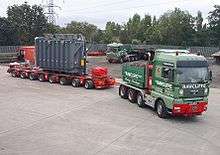Ballast tractor
A ballast tractor is a specially weighted tractor unit of a heavy hauler combination. It is designed to utilize a drawbar to pull or push heavy or exceptionally large trailored loads. When feasible, lowboy-style semi-trailers are used to minimize a load's center of gravity. Typical drivetrains are 6×4 and 6×6.
Typical ballast tractor loads include oil rig modules, bridge sections, buildings, ship sections, and industrial machinery such as generators and turbines.
Only a handful of manufacturers produce dedicated ballast tractors. Extra-heavy-duty chassis versions of mass-production tractor units are fitted with drawbar hitches and a separate ballast box as an alternative.
Increasingly, remote-controlled, self-propelled modular transporters (SPMT) are being employed in traditional ballast tractor/trailer roles.
Description

The ballast tractor's name derives from the nautical term "sailing ballast" describing heavy material added to a vessel to improve stability. For a ballast tractor, ballast is added over the driving wheels to maximize traction. The additional weight increases the friction between the tyres and the road surface, allowing the tractor to overcome the inertia and friction of moving a heavy trailed load. Without it, there would be unproductive wheelspin.
With a semi-trailer, ballast is added in the form of the weight of the attached trailer pressing down upon the tractor's fifth wheel. Since the load is separate from a ballast tractor, it provides no ballast: the drawbar only transmits a horizontal force.
High inertia is encountered when starting to move a heavy load. To overcome this, ballast tractors tend to have high powered, low geared engines that provide substantial torque, especially at low speeds. Additionally, ballast tractors are often fitted with heavy duty hub reduction axles, a combination resulting in exceptionally low maximum speeds.
A strong chassis is required to both support the extra ballast weight and pulling forces transmitted by the drawbar. A reinforced chassis also allows multiple tractors to be coupled together to maximize power and traction. Heavy-duty versions of commercial tractor units may be fitted with a ballast box and suitable drawgear, or a ballast tractor may be purpose-built. Ballast is placed above the driving axle, or spread out over multiple driving axles to maximize traction on each and evenly distribute its load.
A purpose built ballast tractor tends to be the heaviest class of on-road trucks. In some cases, its kerb weight can be greater than their axle configuration's legal Gross Vehicle Weight (GVW) permits, requiring special permission to use public roads.
Typical ballast tractor configurations employ an independent drawbar trailer, modular wheel-trailer units, or dolly trailer. An advantage of using ballast tractors is the ability to push-steer a trailer around a corner. A girder trailer, for example, is double-articulated so the front tractor can pull the load around a corner while the rear tractor pushes it through, thereby making the load more manoeuvrable than a simple towing configuration. Use of a following tractor also can increase control and brake force descending an incline.
Manufacturers
Only a handful of manufacturers produce dedicated ballast tractors. Most high-volume manufacturers offer heavy duty chassis versions of certain tractor units which enable a ballast box to be fitted. In Europe, manufacturers tend to send some of their products to another company (owned by the parent) to be converted into a special heavy duty version.
- Belgium
- Canada
- Czech Republic
- France
- Nicolas Tractomas 8×8 and 10×10 ultra-heavy-duty tractors
- PRP
- Willème
- Germany
- Faun GmbH
- MAN (OAF)
- Mercedes Benz (Titan)
- India
- Italy
- Netherlands
- DAF (GINAF)
- Russia (or former Soviet Union)
- Spain
- BTO Trabosa
- TMU
- Switzerland
- UK
- Atkinson Vehicles Ltd
- Foden Trucks
- Rotinoff Motors – 35 heavy haulage tractors were built by the company between 1952 and 1959, of which 11 are known to survive.
- Scammell[1] – Many early examples, now used and seen as showman's vehicles, originally served with the army.
- Thornycroft
- Unipower
- USA
- Diamond T - Ex-army Diamond T M20 tank transports were popular post World War II with heavy hauliers in the UK.
- Kenworth
- Mack
- White
- Oshkosh Corporation
Operators
Most heavy haulage and heavy lift engineering firms employ heavy duty tractor-unit models that can accommodate a ballast box. Countries where modernisation is taking place, such as regions of the Middle East and South Africa, operate larger number of ballast tractors due to the greater frequency of heavy loads (such as power station components).
Apart from being used by fairgrounds as a direct replacement for the steam-powered showman's engine, specialist moving and haulage companies use ballast tractors. These include:
- Abnormal Load Engineering - specialist in moving transformers and turbines for power stations, from GEC at Stafford.[2]
- Alstom
- Mammoet
- Pickfords[1]
Gallery
-

Scammell Contractor ballast tractor pulling specialist trailer at a fair
-

Scammell ballast tractor. Note the front drawbar coupling for pushing heavy loads
-

Atkinson ballast tractor
-

Three of the 11 surviving Rotinoff Atlantic ballast tractors
-

6×4 Diamond T980 ballast tractor of an M19 Tank Transporter used for heavy haulage in Great Britain once surplussed
-

The 6×6 Finnish Sisu K-50SS, the largest motor vehicle ever built in the Nordic countries
See also
- Heavy hauler
- Prime mover
- Ringfeder
- Road locomotive – steam-powered fore-runner of the ballast tractor
- Toter
- Tractor unit
- Sisu K-50SS
References
- 1 2 "Thimbleby & Shorland - commercial vehicles spares and accessories memorabilia, models, literature pictures and prints auction Saturday 25th March 2006" (pdf). 25 March 2006. p. 16. Archived (PDF) from the original on 26 September 2007. Retrieved 2007-09-14.
This very smart tri axle [Scammell Junior Constructor] ballast tractor was one of six supplied new to Pickfords in 1958.
- ↑ High, Wide & Heavy by David Lee, Published by Round Oak, ISBN 1-871565-47-2
External links
| Wikimedia Commons has media related to Ballast tractors. |
